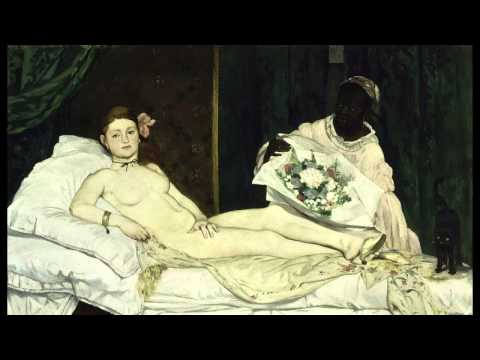11.40: Manet, Olimpia
- Page ID
- 102867
\( \newcommand{\vecs}[1]{\overset { \scriptstyle \rightharpoonup} {\mathbf{#1}} } \)
\( \newcommand{\vecd}[1]{\overset{-\!-\!\rightharpoonup}{\vphantom{a}\smash {#1}}} \)
\( \newcommand{\id}{\mathrm{id}}\) \( \newcommand{\Span}{\mathrm{span}}\)
( \newcommand{\kernel}{\mathrm{null}\,}\) \( \newcommand{\range}{\mathrm{range}\,}\)
\( \newcommand{\RealPart}{\mathrm{Re}}\) \( \newcommand{\ImaginaryPart}{\mathrm{Im}}\)
\( \newcommand{\Argument}{\mathrm{Arg}}\) \( \newcommand{\norm}[1]{\| #1 \|}\)
\( \newcommand{\inner}[2]{\langle #1, #2 \rangle}\)
\( \newcommand{\Span}{\mathrm{span}}\)
\( \newcommand{\id}{\mathrm{id}}\)
\( \newcommand{\Span}{\mathrm{span}}\)
\( \newcommand{\kernel}{\mathrm{null}\,}\)
\( \newcommand{\range}{\mathrm{range}\,}\)
\( \newcommand{\RealPart}{\mathrm{Re}}\)
\( \newcommand{\ImaginaryPart}{\mathrm{Im}}\)
\( \newcommand{\Argument}{\mathrm{Arg}}\)
\( \newcommand{\norm}[1]{\| #1 \|}\)
\( \newcommand{\inner}[2]{\langle #1, #2 \rangle}\)
\( \newcommand{\Span}{\mathrm{span}}\) \( \newcommand{\AA}{\unicode[.8,0]{x212B}}\)
\( \newcommand{\vectorA}[1]{\vec{#1}} % arrow\)
\( \newcommand{\vectorAt}[1]{\vec{\text{#1}}} % arrow\)
\( \newcommand{\vectorB}[1]{\overset { \scriptstyle \rightharpoonup} {\mathbf{#1}} } \)
\( \newcommand{\vectorC}[1]{\textbf{#1}} \)
\( \newcommand{\vectorD}[1]{\overrightarrow{#1}} \)
\( \newcommand{\vectorDt}[1]{\overrightarrow{\text{#1}}} \)
\( \newcommand{\vectE}[1]{\overset{-\!-\!\rightharpoonup}{\vphantom{a}\smash{\mathbf {#1}}}} \)
\( \newcommand{\vecs}[1]{\overset { \scriptstyle \rightharpoonup} {\mathbf{#1}} } \)
\( \newcommand{\vecd}[1]{\overset{-\!-\!\rightharpoonup}{\vphantom{a}\smash {#1}}} \)
La Dra. Beth Harris y el Dr. Steven Zucker proporcionan una descripción, perspectiva histórica y análisis de la Olimpia de Manet.
Édouard Manet, Olimpia, 1863, óleo sobre lienzo, 130.5 cm × 190 cm (51.4 in × 74.8 in), (Musée d'Orsay, París).
Édouard Manet trajo al Realismo su curiosidad por las formas sociales. Sin embargo, no le interesaba reflejar conversaciones educadas de salón y paseos de clase media en el Bois de Boulogne (Central Park de París). Más bien, Manet inventó temas que ponían al borde los dientes de los parisinos.
En 1865, Manet presentó su atrevida pintura de una cortesana saludando a su cliente (en este caso, usted), Olimpia, de 1863, al Salón Francés. El jurado del Salón 1865 aceptó esta pintura a pesar de su desaprobación del tema, pues dos años antes, Manet's Luncheon on the Grass creó tal revuelo cuando fue rechazada del Salón. (En cambio, se exhibió en la exposición conciliatoria del emperador Napoleón III, el Salon des Réfusés, o la Exposición de los Rechazados. Multitudes acudieron al Salón des Réfusés específicamente para reír y burlarse de lo que consideraban la locura de Manet.)
De alguna manera tenían miedo de que otro rechazo pareciera un ataque personal al propio Manet. El razonamiento era extraño, pero el resultado fue el mismo: Olympia se volvió infame y la pintura tuvo que colgarse muy alto para protegerla de ataques físicos.
Manet era realista, pero a veces sus situaciones “reales” conmocionaban y sacudieron el mundo del arte parisino hasta sus cimientos. Su trabajo posterior fue mucho más domador.
Colaboradores
- Manet, Olimpia. Autor: Dra. Beth Harris y Dr. Steven Zucker; Texto de la Dra. Beth Gersh-Nesic. Proporcionado por: Khan Academy. Ubicado en: www.khanacademy.org/humanidades/convertirse-modern/avant-garde-france/realism/v/manet-olympia-1863-expuesto-1865. Licencia: CC BY-NC-SA: Atribución-NoComercial-CompartirIgual


